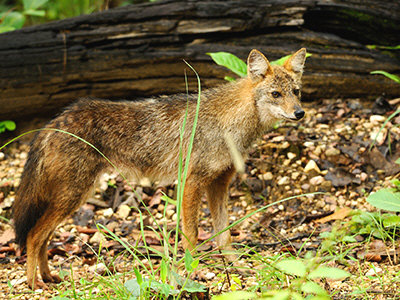 |
Order : CARNIVORA
Family : Viverridae
Species : Canis aureus
Head-body length : up to 80 cm
Tail length : up to 25 cm
Weight : up to 10 kg
The Golden Jackal is a medium-sized canid which
mainly inhabits dry, open habitats, and is less likely to be found in
wet, evergreen forests.
They are mainly nocturnal in habits, but may be observed early morning or
late afternoon: during the heat of the day they tend to shelter in the cool
of their burrows. Their call is described as a series of whines and yelps,
which may be heard just before dawn or just after dusk.
In parts of India they may form large packs, but in Southeast Asia they are
generally solitary or travel in pairs. Typical family groups comprise a
male, female and four to five pups.
Their prey mainly comprises small vertebrates, for example rodents, lizards
and frogs, but they will also consume carrion and the remains of animals
killed by larger predators.
Their size distinguishes them from the much larger Dhole
Cuon alpinus and from typical feral 'domestic' dogs.
Their fur is golden brown to greyish brown in colour, and somewhat shaggy in
texture. The hair on the back and upper flanks is tipped with black, as is
the end of the bushy tail. The snout is pointed and the ears are held erect
at all times.
Golden jackals are wide-ranging and occur on three continents - Africa,
Europe and Asia. Within Southeast Asia they are limited to drier habitats of
Myanmar, Thailand, Cambodia, Laos and Vietnam.
Figs 1 and 2 : Golden Jackal in Huai Kha Khaeng National Park, Thailand. Image
courtesy Tontantravel.
Fig 3 : Example with well developed dark-tipped fur on the flanks. Seen at
Kaeng Krachan National Park, Phetchaburi, Thailand. Photo thanks to
Charles Currin.
References :
Francis, C.M. 2019. A Field Guide to the Mammals of South-east Asia. Second
Edition. New Holland. 416 pp.
Lekagul, B., McNeely, J., 1977. Mammals of Thailand. Association for the
Conservation of Wildlife, Thailand. 758 pp.
|